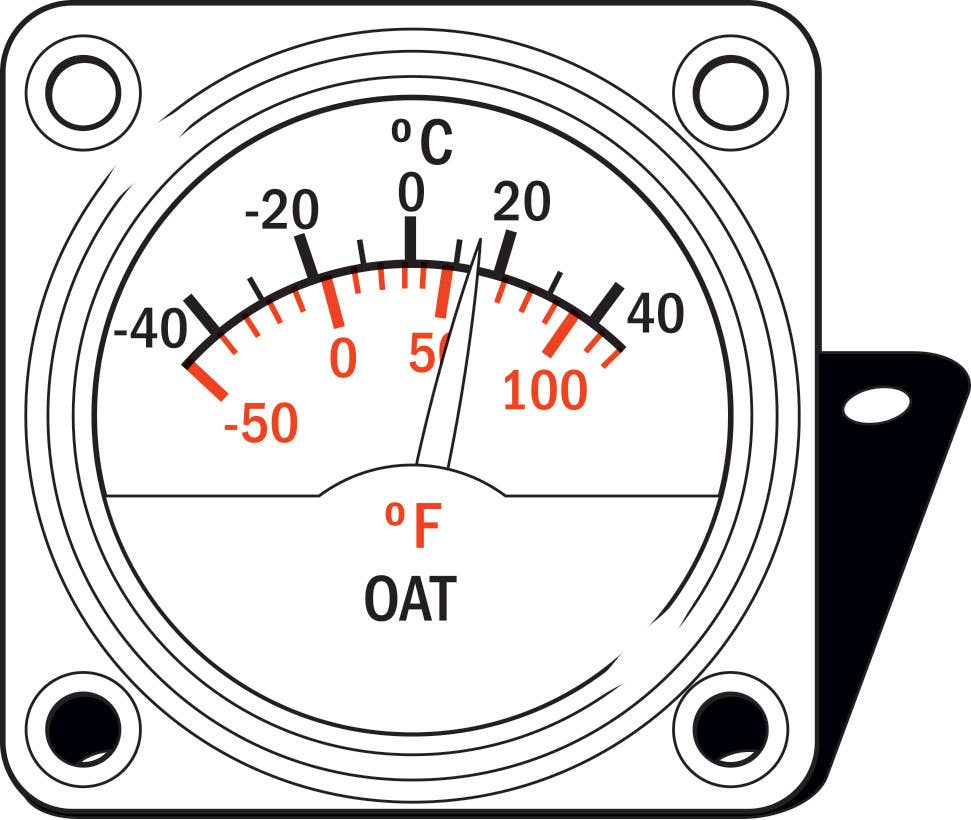
A gauge shows outside air temperature. Illustration by Tim Barker
1. SAT — Static air temperature (sometimes called true air temperature) is the temperature of undisturbed air; that is, the temperature you would read if you could suspend a thermometer out in the air without having the effects (temperature rise) of an airplane moving through the air nearby. In jets, SAT (aka OAT) is determined by applying the appropriate correction factor to the total air temperature (TAT), or ram air temperature (RAT), probe data. Most large jet aircraft have this function incorporated into the air-data computer. SAT is the actual air temperature, also referred to as true outside temperature or ambient temperature.
2. OAT — Outside air temperature is essentially the same as SAT. Above 200 knots, a normal OAT probe can't give an accurate reading because air friction and compressibility cause the indicated temperature to rise.
3. RAT — Ram air temperature is normally interchangeable with total air temperature. It is the temperature that the ram air temperature probe senses. Think of it as "ram rise" (RR) and TAT. Ram rise occurs to a small degree at all airspeeds, but it only really starts becoming a factor above 200 knots. At typical jet speeds, RAT may be 15 to 30 degrees C higher than the actual outside air temperature. It is defined as: "The increase in temperature created by the ram compression on the surface of an aircraft traveling at a high rate of speed through the atmosphere. The rate of increase is proportional to the square of the speed of the object." (AC 65-15A).
4. A Rosemount probe (Rosemount Aerospace) or similar device (resembling a pitot tube) corrects for ram rise and can display static air temperature (actual OAT) in the cockpit.
5. TAT — Total air temperature is the SAT (actual OAT) plus the temperature rise associated with high-speed flight. This temperature increase is called "ram rise" and is the result of heating of the air due to compression. From a practical standpoint, TAT (or RAT) is the temperature the airplane's skin feels, while SAT is the free air's temperature (aka OAT). TAT is greater than SAT due to the ram rise in temperature that occurs because of dynamic heating. Ram air temperature rise is proportional to the speed of the aircraft. At 0.8 Mach or higher, a ram rise of 30 degrees C can be expected. This rise in temperature may be enough to prevent ice from forming.
6. Example — If the SAT (OAT) is minus 50 degrees C at FL 350, the TAT (RAT) may be minus 20 degrees C due to ram-rise effect. The ram rise, in this case, would be 30 degrees C.
**7. **Total air temperature (or RAT) is the important number when considering the formation of ice on the airframe, engine nacelles and inside the fuel tanks, and can even have an effect on EPR settings. In the extremely cold air of the far north, there may be a need to increase the aircraft’s speed (and/or use a lower altitude) to increase TAT so as to increase the temperature inside the fuel tanks to prevent the fuel from freezing. An actual fuel temperature gauge can be an important safety item when flying in these harsh conditions.
8. TAT (or RAT) is used when deciding to switch on the engine anti-ice. SAT (OAT) may be below freezing, but the aircraft is experiencing TAT (OAT plus ram rise). Most manufacturers require engine anti-ice when the TAT (or RAT) falls below 10 degrees C in visible moisture.
9. The approved aircraft flight manual should have a chart showing the expected ram rise at various Mach numbers. The term RAT is most often interchangeable with TAT in flight manual charts.
10. The aircraft may have any combination of RAT, TAT, SAT or OAT gauges. Be sure to refer to the proper ones when making anti-ice decisions.

Sign-up for newsletters & special offers!
Get the latest FLYING stories & special offers delivered directly to your inbox






